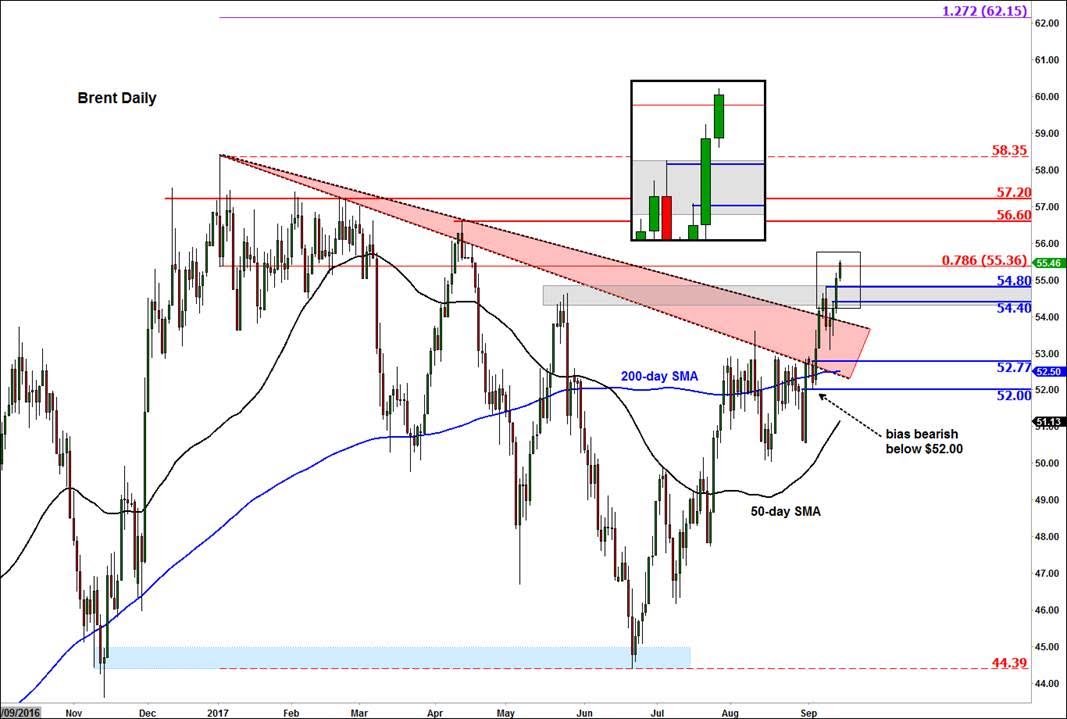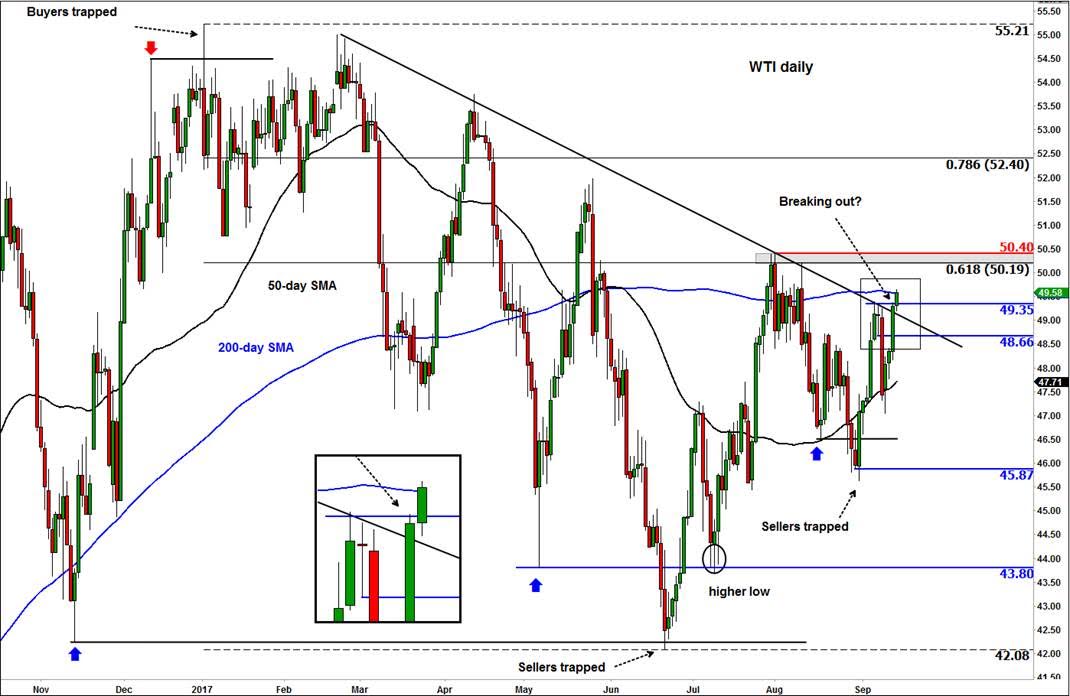Crude oil prices are up for the fourth consecutive day, with Brent also being up for the third straight week and WTI for the second. A number of fundamental factors are helping to support oil prices at the moment. In short, stronger demand and ongoing supply restrictions from the OPEC and Russia are the main reasons for the oil price upsurge. Production fell in Libya, Gabon, Venezuela and Iraq, which helped to cause OPEC's supply drop by 79,000 barrels a day to 32.76 million in August. This has eased concerns that the oil cartel's deal with a number of non-OPEC producers to restrict supply was not working. In fact, non-OPEC producers like Russia have been quite compliant with the production cuts thus far. The OPEC itself has largely stuck to the agreement and has repeatedly suggested it would increase the production agreement in the event OECD oil inventories do not fall as expected. Meanwhile demand for oil surged in the second quarter, most notably from OECD countries including Germany and the US, according to the International Energy Agency (IEA). The IEA now expects oil demand growth of 1.6 million barrels per day this year and 1.4 million next. In the US, while crude inventories have surged higher as a result of the hurricanes, production is likely to have fallen sharply as the storms rampaged through the oil producing regions in Texas and Louisiana. The supply disruptions here have also helped to boost energy prices. But in the medium to long term, the direction of oil prices will be influenced to a great degree by US crude production changes. As oil prices stabilise further, US shale oil production is likely to increase. This will probably keep a lid on oil prices in the long-term. But in the short-term, we maintain our bullish view.
As a result of the oil price upsurge, both oil contracts have broken out of their respective key resistance areas. Consequently, the path of least resistance is now clearly to the upside for both contracts. This means we expect the dips to be bought and rips to be used as profit-taking opportunity rather than actual selling. This view will remain in place until the charts tell us oil prices have topped out. Brent has taken out a band of resistance in the $52.50-$54.50 range. Here, a number of technical indicators had converged, including, but not limited to, the 200-day average, a couple of bearish trend lines and horizontal resistance. Brent now needs to hold above this area on any potential re-test, to maintain its bullish bias. Specifically, the key short-term support area to watch now is between $54.40 and $54.80; this range was previously resistance. In terms of resistance or bullish objectives for Brent, levels such as $56.60, 57.20 and the 2016 high at $58.35 are the ones to watch going forward. At this stage, only a break below $52.00, would, in our opinion, invalidate the short-term bullish view. Meanwhile WTI has taken out its own bearish trend line, although unlike Brent, it is lagging behind not just in terms of price but also in terms of its current location relative to its corresponding technical levels. For example, unlike Brent, WTI is still hanging around its 200-day average and it is yet to break above the previous swing high at $54.40. Nonetheless, we expect WTI to follow Brent prices higher. Still, out of the two contracts, Brent is the obvious choice for bulls. This makes WTI the ideal candidate for the bears when oil prices start rolling over again.
Trading leveraged products such as FX, CFDs and Spread Bets carry a high level of risk which means you could lose your capital and is therefore not suitable for all investors. All of this website’s contents and information provided by Fawad Razaqzada elsewhere, such as on telegram and other social channels, including news, opinions, market analyses, trade ideas, trade signals or other information are solely provided as general market commentary and do not constitute a recommendation or investment advice. Please ensure you fully understand the risks involved by reading our disclaimer, terms and policies.
Recommended Content
Editors’ Picks
EUR/USD clings to daily gains above 1.0650

EUR/USD gained traction and turned positive on the day above 1.0650. The improvement seen in risk mood following the earlier flight to safety weighs on the US Dollar ahead of the weekend and helps the pair push higher.
GBP/USD recovers toward 1.2450 after UK Retail Sales data

GBP/USD reversed its direction and advanced to the 1.2450 area after touching a fresh multi-month low below 1.2400 in the Asian session. The positive shift seen in risk mood on easing fears over a deepening Iran-Israel conflict supports the pair.
Gold holds steady at around $2,380 following earlier spike

Gold stabilized near $2,380 after spiking above $2,400 with the immediate reaction to reports of Israel striking Iran. Meanwhile, the pullback seen in the US Treasury bond yields helps XAU/USD hold its ground.
Bitcoin Weekly Forecast: BTC post-halving rally could be partially priced in Premium

Bitcoin price shows no signs of directional bias while it holds above $60,000. The fourth BTC halving is partially priced in, according to Deutsche Bank’s research.
Week ahead – US GDP and BoJ decision on top of next week’s agenda

US GDP, core PCE and PMIs the next tests for the Dollar. Investors await BoJ for guidance about next rate hike. EU and UK PMIs, as well as Australian CPIs also on tap.

